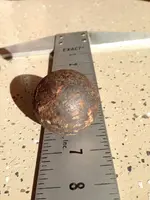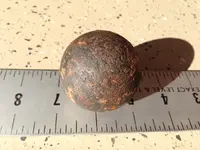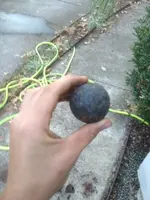You are using an out of date browser. It may not display this or other websites correctly.
You should upgrade or use an alternative browser.
You should upgrade or use an alternative browser.
How do determine if this is a cannonball?
- Thread starter cdism
- Start date
SCDigginWithAK
Bronze Member
- Joined
- Mar 31, 2012
- Messages
- 1,489
- Reaction score
- 357
- Golden Thread
- 0
- Location
- South Carolina
- Detector(s) used
- Garrett AT Pro, Garrett Ace 350, Garrett Pro Pointer, Fisher F2
- Primary Interest:
- Metal Detecting
It would be a grapeshot since it's that small. But I can't confirm that since I'm not an expert. Could also be a mill grinding ball which is always a possibility. Wait for TNet's artillery expert, TheCannonballGuy, to chime in. He will give you an exact answer. Welcome to TreasureNet
Last edited:
cdism
Tenderfoot
- Joined
- Dec 23, 2013
- Messages
- 3
- Reaction score
- 0
- Golden Thread
- 0
- Primary Interest:
- All Treasure Hunting
- #4
Thread Owner
That's what I was thinking. I am having trouble with identification as I found it in wood chips used for ground cover in suburbia of all places. Must have been scooped up along with the wood is all I can think of.
cdism
Tenderfoot
- Joined
- Dec 23, 2013
- Messages
- 3
- Reaction score
- 0
- Golden Thread
- 0
- Primary Interest:
- All Treasure Hunting
- #5
Thread Owner
Well that makes sense... just looked up a mill ball and though mine has no seams, I am pretty sure that's what I have found. Especially since it was found in the crushed wood chips... Dang it! Another fantasy of finding an antique cannon ball ruined!  Seriously though, learned a lot about cannon balls this morning and if I ever do find a real one, I will certainly post it here first. Thanks for the warm welcome.
Seriously though, learned a lot about cannon balls this morning and if I ever do find a real one, I will certainly post it here first. Thanks for the warm welcome.
 Seriously though, learned a lot about cannon balls this morning and if I ever do find a real one, I will certainly post it here first. Thanks for the warm welcome.
Seriously though, learned a lot about cannon balls this morning and if I ever do find a real one, I will certainly post it here first. Thanks for the warm welcome.carcusrex
Full Member
- Joined
- Jan 2, 2012
- Messages
- 165
- Reaction score
- 66
- Golden Thread
- 0
- Detector(s) used
- Minelab E-TRAC, Minelab GPX 5000
- Primary Interest:
- Metal Detecting
This is one of the reasons why I like this web site so much. So many great people here to share thier knowledge and I learn something just about every day I visit this site.
Last edited:
DocBeav
Bronze Member
- Joined
- Jul 8, 2012
- Messages
- 1,703
- Reaction score
- 3,185
- Golden Thread
- 1
- Location
- SE Va
- 🥇 Banner finds
- 1
- 🏆 Honorable Mentions:
- 6
- Detector(s) used
- Minelab Equinox 800, Minelab CTX 3030 (17", 11", 6" coils), Minelab Excalibur 800, Minelab Excalibur 1000 (w/OBN's Remote Pinpoint mod and CTX headphone connector)
- Primary Interest:
- All Treasure Hunting
Cannonballguy will be along shortly I'm sure! He's the one to help you with an ID on it.
Guldgrävaren_98
Jr. Member
- Joined
- May 27, 2013
- Messages
- 32
- Reaction score
- 32
- Golden Thread
- 0
- Detector(s) used
- Minelab X-Terra 705, Garrett Pro Pointer
- Primary Interest:
- Metal Detecting
I have found a few cannonballs just like that here in Sweden... Nice find! 

SCDigginWithAK
Bronze Member
- Joined
- Mar 31, 2012
- Messages
- 1,489
- Reaction score
- 357
- Golden Thread
- 0
- Location
- South Carolina
- Detector(s) used
- Garrett AT Pro, Garrett Ace 350, Garrett Pro Pointer, Fisher F2
- Primary Interest:
- Metal Detecting
I don't know, it certainly looks similar to the grapeshot ball I found but I PMed TheCannonballGuy for you. Here is what mine looks like. <img src="http://www.treasurenet.com/forums/attachment.php?attachmentid=917153"/>
Yeah it could be either im thinking. I'm surprised he hasn't said anything yet. To the OP- What state are you in? That would help also!
TheCannonballGuy
Gold Member
- Joined
- Feb 24, 2006
- Messages
- 6,607
- Reaction score
- 13,455
- Golden Thread
- 0
- Location
- Occupied CSA (Richmond VA)
- Detector(s) used
- White's 6000, Nautilus DMC-1, Minelab
- Primary Interest:
- Relic Hunting
SCDigginWithAK, the reason I hadn't said anything yet is, I do not read the Today's Finds forum every day, because very few posters ask for a relic-ID in it. I spend almost all my time here at TreasureNet in the What-Is-It forum, where my services are most often needed. So, if you see something that needs an ID in Today's Finds, please send me a PM heads-up about it, like Ekeisler did abut this iron ball. Also, please be sure to tell me the name the post it's in.
Cdism, I co-wrote an Educational article which gives detailed information and instructions for how to tell an actual Artillery ball (cannonballs, Grapeshot balls, and Canister balls) from one of the many varieties of Civilian-usage (non-artillery) metal balls. Please read it and follow the instructions in it. SolidShotEssentialsMod
Some examples of the Civilian-usage metal balls are:
"Mill-balls" from the Mining-&-Stonemilling Industry,
"Ornamental Ironwork" balls (such as a gatepost-top),
pump check-valve balls,
ball-bearings (some are quite large),
machinery counterweight balls,
cement-delivery tank "cleaner" balls
Sports Shot Put balls.
As the article instructs (with photos), please measure the ball with a Digital Caliper, which will tell you the ball's diameter in hundredths-of-an-inch. Next, weigh the ball on a precision Postal Shipping scale, which measures in pounds AND ounces. Then, compare the ball's precisely-measured diameter and weight with the data in the charts from the US (and CSA) Ordnance Manual, to see if your solid (not hollow) ball matches any of the balls in the Manual's data. You can view it online, for free, at: www.civilwarartillery.com/shottables.htm
Meanwhile... I can tell you that the nearest Artillery ball match-up with the estimated diameter and weight you reported is a 12-Pounder caliber Grapeshot ball or a 32-pounder caliber Canister ball (for both of those, the specified diameter is 2.03-to-2.05-inches, weight 1 pound 2 ounces). When you've precisely measured your ball, let us know if it matches that size and weight.
A caution-note:
If the ball is the correct diameter but is more than one ounce heavier than 1 pound 2 ounces, it is a steel ball -- which excludes it from being an Artillery ball, because there were no steel Grapeshot balls or Canister balls.
Cdism, I co-wrote an Educational article which gives detailed information and instructions for how to tell an actual Artillery ball (cannonballs, Grapeshot balls, and Canister balls) from one of the many varieties of Civilian-usage (non-artillery) metal balls. Please read it and follow the instructions in it. SolidShotEssentialsMod
Some examples of the Civilian-usage metal balls are:
"Mill-balls" from the Mining-&-Stonemilling Industry,
"Ornamental Ironwork" balls (such as a gatepost-top),
pump check-valve balls,
ball-bearings (some are quite large),
machinery counterweight balls,
cement-delivery tank "cleaner" balls
Sports Shot Put balls.
As the article instructs (with photos), please measure the ball with a Digital Caliper, which will tell you the ball's diameter in hundredths-of-an-inch. Next, weigh the ball on a precision Postal Shipping scale, which measures in pounds AND ounces. Then, compare the ball's precisely-measured diameter and weight with the data in the charts from the US (and CSA) Ordnance Manual, to see if your solid (not hollow) ball matches any of the balls in the Manual's data. You can view it online, for free, at: www.civilwarartillery.com/shottables.htm
Meanwhile... I can tell you that the nearest Artillery ball match-up with the estimated diameter and weight you reported is a 12-Pounder caliber Grapeshot ball or a 32-pounder caliber Canister ball (for both of those, the specified diameter is 2.03-to-2.05-inches, weight 1 pound 2 ounces). When you've precisely measured your ball, let us know if it matches that size and weight.
A caution-note:
If the ball is the correct diameter but is more than one ounce heavier than 1 pound 2 ounces, it is a steel ball -- which excludes it from being an Artillery ball, because there were no steel Grapeshot balls or Canister balls.
Last edited:
SCDigginWithAK
Bronze Member
- Joined
- Mar 31, 2012
- Messages
- 1,489
- Reaction score
- 357
- Golden Thread
- 0
- Location
- South Carolina
- Detector(s) used
- Garrett AT Pro, Garrett Ace 350, Garrett Pro Pointer, Fisher F2
- Primary Interest:
- Metal Detecting
SCDigginWithAK, the reason I hadn't said anything yet is, I do not read the Today's Finds forum every day, because very few posters ask for a relic-ID in it. I spend almost all my time here at TreasureNet in the What-Is-It forum, where my services are most often needed. So, if you see something that needs an ID in Today's Finds, please send me a PM heads-up about it, like Ekeisler did abut this iron ball. Also, please be sure to tell me the name the post it's in. Cdism, I co-wrote an Educational article which gives details information and instructions for how to tell an actual Artillery ball (cannonballs, Grapeshot balls, and Canister balls) from one of the many varieties of Civilian-usage (non-artillery) metal balls. Please read it and follow the instructions in it. SolidShotEssentialsMod Some examples of the Civilian-usage metal balls are: "Mill-balls" from the Mining-&-Stonemilling Industry, "Ornamental Ironwork" balls (such as a gatepost-top), pump check-valve balls, ball-bearings (some are quite large), machinery counterweight balls, cement-delivery tank "cleaner" balls Sports Shot Put balls. As the article instructs (with photos), please measure the ball with a Digital Caliper, which will tell you the ball's diamter in hundredths-of-an-inch. Next, weigh the ball on a precision Postal Shipping scale, which measures in pounds AND ounces. Then, compare the ball's precisely-measured diameter and weight with the data in the charts from the US (and CSA) Ordnance Manual, to see if your "solid" (not hollow) ball matches any of the balls in the Manual's data. You can view it online, for free, at: www.civilwarartillery.com/shottables.htm Meanwhile... I can tell you that the nearest Artillery ball match-up with the estimated diameter and weight you reported is a 12-Pounder caliber Grapeshot ball or a 32-pounder caliber Canister ball (for both of those, the specified diameter is 2.03-to-2.05-inches, weight 1 pound 2 ounces). When you've precisely measured your ball, let us know if it matches that size and weight. A caution-note: If the ball is the correct diameter but is more than one ounce heavier than 1 pound 2 ounces, it is a steel ball -- which excludes it from being an Artillery ball, because there were no steel Grapeshot balls or Canister balls.
Oh wow sorry! I didn't realize this was today's finds. I kept switching between each. I thought It was What Is It so I was confused haha. Have a Merry Christmas TheCannonballGuy, ekeisler, And all others on the thread. Once again sorry! Lol
Similar threads
- Replies
- 2
- Views
- 489
- Replies
- 65
- Views
- 5K
- Replies
- 0
- Views
- 474
Users who are viewing this thread
Total: 1 (members: 0, guests: 1)







